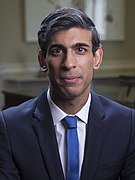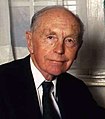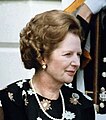Conservative Party (UK)
The Conservative Party (informally as the Tory Party) is the main right wing, sometimes centre-right, political party in the United Kingdom. Their policies usually promote conservatism. They are the currently the largest party in the House of Commons after the 2019 United Kingdom general election, with 365 out of a possible 650 seats.
The party has generally had liberal economic policies that favour free market economics. The party is British unionist, historically opposing Irish reunification, Scottish and Welsh independence, and is generally critical of devolution.
After a leadership election in the Conservative Party in July, August and September 2022, Liz Truss became the leader of the party. She became Prime Minister on 6 September 2022 by default.
Truss announced her resignation as Prime Minister on 20 October 2022,[13] after just 44 days in office.[14][15] This is the shortest Prime Minister's term in British political history.[13]
History[change | change source]
19th century[change | change source]

The party was founded in 1834 by Robert Peel out of the old Tory Party, which was founded in 1678. During the 1800s, the party was one of the two main political parties along with the Liberal Party. In 1846, the party split over the repeal of the 'Corn Laws', which was favoured by Robert Peel and most top Conservatives but was disliked by backbencher Conservative MPs. Following the repeal, the Peel government fell and Robert Peel and his followers went on to join the Liberal Party. Because of this, the Conservatives were not able to form a majority government for twenty-eight years.
Under the leadership of Benjamin Disraeli, the party created a philosophy which supported the British Empire, the Church of England, the monarchy and social reforms, which took the party into power from 1874 to 1880. In 1886, the Liberal Party split over whether Ireland should be given independence. Those who did not support it became known as the Liberal Unionists and they joined with the Conservatives. This alliance meant that the Conservatives were in power for most of the period 1885–1906, under Lord Salisbury and then Arthur Balfour.
Early and middle 20th century[change | change source]

By 1906, the Conservatives had another split, this time about the issue of 'tariff reform' and as a result, the party was defeated in a landslide at the 1906 General Election by the Liberal Party. In 1912, the Conservative Party formally joined with the Liberal Unionist Party to create the modern-day Conservative and Unionist Party, however this is usually shortened to Conservative Party. The party was in a coalition with the Liberal Party from 1916 to 1922, and was mostly in power from 1922 to 1929 under Stanley Baldwin. During the 1920s, the Labour Party replaced the Liberals as the Conservative's main political opponent.
The Conservatives were the leading figure in the coalitions of 1931–1935 and 1940–1945, and Winston Churchill was Prime Minister during World War II. Labour defeated the Conservatives at the 1945 General Election and the Conservatives were forced to accept many of Labour's new reforms like the creation of the welfare state and high taxes. The Conservatives returned to power from 1951 to 1964, under Churchill, Anthony Eden, Harold Macmillan and Alec Douglas-Home and during this time, Britain saw a period of economic and national prosperity. The Conservatives were led by Edward Heath from 1965 to 1975 and were in power from 1970 to 1974.
Late 20th century[change | change source]

Whilst Heath was in power, he took Britain into the European Union which later would deeply divide the Conservative Party. Direct rule had to be placed on Northern Ireland because of the violence that occurred because of The Troubles. After this, the Ulster Unionist Party stopped supporting the Conservative Party at Westminster. A miner's strike and rising inflation in 1973 caused Heath to start the three-day working week to ration power. The February 1974 General Election caused a hung parliament and Labour was in power until 1979.
Margaret Thatcher became Conservative leader in 1975 and successfully introduced a number of monetarist policies. In 1979, the party was returned to power because of the Labour government's handling of the 'Winter of Discontent' and Britain's growing inflation. Thatcher was Prime Minister from 1979 to 1990 and won the General Elections of 1979, 1983 and 1987. Thatcher's second and third terms saw the privatisation of most of Britain's state-owned industry, such as British Telecom in 1984, British gas in 1986, British Airways in 1987 and British Leyland and British Steel in 1988.
In 1989, the Conservative government introduced the Community Charge, or 'Poll Tax' which was seen as unfair to the poor and was very unpopular. Thatcher was replaced as Prime Minister and Conservative Party leader in 1990 by John Major. Major led the country and the party until 1997. John Major replaced the unpopular Community Charge with the Council Tax in 1992 and led the party to a surprise victory in the 1992 General Election. Although there was a recession in the early 1990s, John Major's Conservative government started a long period of economic prosperity which would last until the late 2000s. In the 1997 General Election, the Conservatives were defeated in a landslide and lost all of their Scottish and Welsh seats. This is blamed on party splits over the European Union, the "Black Wednesday" currency problem in 1992, and the 'New' Labour Party led by Tony Blair.
21st century[change | change source]

The party entered thirteen years of opposition, with William Hague leading the party from 1997 to 2001. At the 2001 General Election, the party's campaign focused on several right-wing policies. Hague was seen as a powerful speaker, but his leadership was damaged by some poor publicity stunts. The party made a net gain of only one seat at the 2001 General Election. Iain Duncan Smith led the party from 2001 to 2003 and he did moderate some of the party's right-wing policies. He did not return the party to power, and Michael Howard became leader in 2003.
The Labour government under Tony Blair was becoming unpopular because of the Iraq War. Michael Howard managed to reduce Labour's majority in parliament at the 2005 General Election, from 167 to 66. Howard resigned soon after this and David Cameron became Conservative Party leader. Cameron focused on modern and environmental issues. The Conservatives had a regular lead in opinion polls from 2007 onwards and at the 2010 General Election, the party won the most seats in parliament and the highest number of votes but was 20 seats short of a majority in parliament. A coalition government was made with the Liberal Democrats and David Cameron became Prime Minister on May 11, 2010. In the United Kingdom general election, 2015 the Conservatives won 331 seats. The first Conservative-majority government since 1992 was formed.
Leaders have adopted policies of liberal conservatism.[16][17] This has included a "greener" environmental and energy policy, and adoption of socially liberal views. An example is the acceptance of same-sex marriage. However, these policies have been accompanied by a fiscal conservatism: they have maintained a hard stance on bringing down the deficit, and starting a programme of economic austerity. Other modern policies of one-nation conservatism include education reform, extending student loan applicants to postgraduate applicants.[18] and Christian democracy.[19][20] Such policies allow poorer students to go further, but still increase tuition fees for the highest earners of society. There has also been an emphasis on human rights. The European Convention on Human Rights is accepted, and individual initiative is supported.[21]
After the UK voted to leave the EU on the 23rd June 2016, Cameron resigned as Conservative leader and PM. On 11 July 2016 it was announced that Theresa May would become the new Leader of the Conservative Party and Prime Minister on the evening of 13 July 2016.
Recent policies include a target to reach net zero C02 emissions by 2050, investment in clean energy and the environment, increased education funding, increased funding in science and research, increased police numbers, and increased NHS (National Health Service) funding.[22] In 2019, the Conservative Party became the first major world government to declare a climate emergency declaration. After the 2019 general election, there are now more LGBT+ Conservative MPs in Parliament.[23]
Party support[change | change source]
Support for the party comes mainly from the South of England, Eastern England and rural areas, however, in recent years, support from the north of England has increased.
Current representation[change | change source]
The Conservative Party has these seats:
House of Commons (MPs) -
House of Lords (Peers) -
London Assembly (AMs) -
Scottish Parliament (MSPs) -
Welsh Assembly (AMs) -
Local Government (Councillors) -
Former leaders[change | change source]
Named below are all of the previous Conservative Party leaders since 1922. Their time as leader is placed in brackets.
-
Andrew Bonar Law (1922–1923)
-
Stanley Baldwin (1923–1937)
-
Neville Chamberlain (1937–1940)
-
Winston Churchill (1940–1946; 1951–1955)
-
Anthony Eden (1955–1957)
-
Harold Macmillan (1957–1963)
-
Alec Douglas-Home (1963–1965)
-
Edward Heath (1965–1975)
-
Margaret Thatcher (1975–1990)
-
John Major (1990–1997)
-
William Hague (1997–2001)
-
Iain Duncan Smith (2001–2003)
-
Michael Howard (2003–2005)
-
David Cameron (2005–2016)
-
Theresa May (2016–2019)
-
Boris Johnson (2019–2022)
-
Liz Truss (2022)
References[change | change source]
- ↑ Wilkins, Jessica (17 March 2018). "Conservatives re-launch youth wing in a bid to take on Labour". PoliticsHome.com. Archived from the original on 9 July 2019. Retrieved 9 July 2019.
- ↑ Wheeler, Brian (5 September 2022). "Tory membership figure revealed". BBC News. Retrieved 5 September 2022.
- ↑ "Capping welfare and working to control immigration". Conservative and Unionist Party. Archived from the original on 9 June 2016. Retrieved 1 July 2016.
- ↑ 4.0 4.1 Nordsieck, Wolfram (2019). "United Kingdom". Parties and Elections in Europe. Archived from the original on 11 October 2012. Retrieved 21 January 2020.
- ↑ Falkenbach, Michelle; Greer, Scott (7 September 2021). The Populist Radical Right and Health
National Policies and Global Trends. Switzerland: Springer International Publishing. p. 143. ISBN 9783030707095. - ↑ James, William (1 October 2019). "Never mind the politics, get a Brexit deal done, says UK business". Reuters. Retrieved 21 September 2019.
- ↑ Vries, Catherine; Hobolt, Sara; Proksch, Sven-Oliver; Slapin, Jonathan (2021). Foundations of European Politics A Comparative Approach. United Kingdom: Oxford University Press. p. 145. ISBN 9780198831303.
- ↑ [5][6][7]
- ↑ 9.0 9.1 Saini, Rima; Bankole, Michael; Begum, Neema (April 2023). "The 2022 Conservative Leadership Campaign and Post-racial Gatekeeping". Race & Class: 1–20. doi:10.1177/03063968231164599.
...the Conservative Party's history in incorporating ethnic minorities, and the recent post-racial turn within the party whereby increasing party diversity has coincided with an increasing turn to the Right
- ↑ "Unleash Britain's Potential". Conservatives. Archived from the original on 23 February 2020. Retrieved 24 February 2020.
- ↑ "Lords by party, type of peerage and gender". Parliament.uk. Archived from the original on 12 June 2015. Retrieved 13 June 2015.
- ↑ "Local Council Political Compositions". Open Council Date UK. 23 January 2018. Archived from the original on 30 September 2017. Retrieved 8 July 2020.
- ↑ 13.0 13.1 "Liz Truss resigns as prime minister after Tory revolt". BBC News. 2022-10-20. Retrieved 2022-10-20.
- ↑ Miguel, Rafa de (2022-10-20). "Liz Truss dimite como primera ministra del Reino Unido tras 44 días en el cargo". El País (in Spanish). Retrieved 2022-10-20.
- ↑ Landler, Mark; Castle, Stephen (2022-10-20). "U.K. Live Updates: Liz Truss Resigns as Prime Minister". The New York Times. ISSN 0362-4331. Retrieved 2022-10-20.
- ↑ "BBC News - David Cameron: I am 'Liberal Conservative'". news.bbc.co.uk. 16 May 2010. Retrieved 2016-09-30.
- ↑ "Can Theresa May even sell her new conservatism to her own cabinet?". The Guardian. 2016-07-16. ISSN 0261-3077. Retrieved 2016-09-30.
- ↑ Quinn, Ben (2016-06-29). "Theresa May sets out 'one-nation Conservative' pitch for leadership". The Guardian. ISSN 0261-3077. Retrieved 2016-09-30.
- ↑ McGuinness, Damien (2016-07-13). "Is Theresa May the UK's Merkel?". BBC News. Retrieved 2016-09-30.
- ↑ ""From Big State to Big Society": Is British Conservatism becoming Christian Democratic? | Comment Magazine". www.cardus.ca. 9 July 2010. Archived from the original on 2016-10-16. Retrieved 2016-09-30.
- ↑ "Where The Tory Leadership Candidates Stand On Human Rights - RightsInfo". 2016-07-04. Retrieved 2016-09-30.
- ↑ "Conservative Manifesto 2019 | Conservatives". www.conservatives.com. Retrieved 2021-10-12.
- ↑ "The UK's parliament is still the gayest in the world after 2019 election". PinkNews - Gay news, reviews and comment from the world's most read lesbian, gay, bisexual, and trans news service. 2019-12-13. Retrieved 2021-10-12.

















